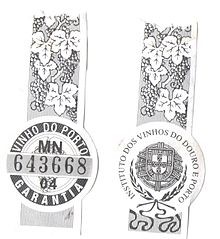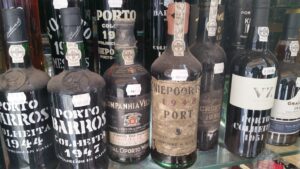
![]() In accordance with Wikipedia, Port wine (also known as vinho do Porto, or simply port is a Portuguese fortified wine produced in the Douro Valley of northern Portugal. It is typically a sweet red wine, often served with dessert, although it also comes in dry, semi-dry, and white varieties.
In accordance with Wikipedia, Port wine (also known as vinho do Porto, or simply port is a Portuguese fortified wine produced in the Douro Valley of northern Portugal. It is typically a sweet red wine, often served with dessert, although it also comes in dry, semi-dry, and white varieties.
Other port-style fortified wines are produced outside Portugal, in Argentina, Australia, Canada, France, India, South Africa, Spain, and the United States. Still, under the European Union Protected Designation of Origin guidelines, only wines from Portugal are allowed to be labeled "port”.
Vintage Port is the most expensive and prestigious member of the Port family (and it is my favorite wine that pairs well with a quality cigar). Although accounting for just a fraction of total Port production, Vintage Port is the Douro's flagship style, attracting attention and speculation worldwide.
A Vintage is 'declared' in only the best years, when both the quality and quantity of the available fruit align. It may take up to two years after harvest for a vintage declaration to be made, and even when one Port shipper judges the conditions sufficient for Vintage Port, other shippers may not necessarily agree. This scenario is highly unusual, though, and has only occurred a handful of times in history.
Vintage Port is made from the best grapes in the Douro, typically from the Cima Corgo sub-region. The grapes are left to achieve full ripeness before they are picked, vinified, and then fortified with a high-proof grape spirit. Vintage Port spends a short time aging in barrel – only two to three years – and is bottled unfiltered when it is still very dense and full of sediment.
This is why Vintage Port's minimum bottle-aging period is considered to be 15 years, and it is often said that no other wine requires as much time in the bottle to balance itself. The finest examples retain their vitality well after 50 years.
Recent critical successes have helped revive interest in the style, and Vintage Port is often considered an alternative to Bordeaux or Burgundy as a complement to the cellar. Decanting Vintage Port before serving is necessary, as the sediment in the bottle can often become crusty over time.
I could tell you a lot about great ports (and I have quite a few of them in my wine cellar). I love this type of wine because, hey, it’s sweet (sometimes it can overpower your palate with sweetness if you buy the cheap port), it’s so flavorful in both smell and taste, and the vintage port is an art form that has been mastered by the greatest wine families for generations!
One of my distant relatives introduced me to Port (with roasted nuts), and since then, I have become the biggest fan of this type of wine.
Most people are accustomed to the notion that a port is a dessert wine; however, my personal opinion is that it’s a significant mistake. There is a simple explanation:
- When you had dinner and ate various foods, your palate is overloaded with the aftertaste of food. So, sipping port after having food will destroy many nuances of the wine.
- When you taste the port before any food, your palate is clean, and you can catch the beautiful flavor of the port wine fully.
 Official guarantee label from a bottle of port.
Official guarantee label from a bottle of port.
If I want a drink after dinner, I’d rather take 2-3 fingers of the bourbon (a cigar is optional), but never port wine, especially vintage. I’d consider it a travesty to drink port after any food (your opinion may vary).
If you understand the beauty of a good port, you MUST travel to Portugal, which is one of my favorite cities in Europe.
I had a chance to fly there in 2016. Lisbon and Porto are two cities that you should not miss. First of all, you will enjoy every moment. There are many great attractions to see and numerous lovely places to visit. I have brought plenty of pictures. Every day was an absolute enjoyment: seeing places and meeting very friendly people.
While in Port, I took an Uber cab to visit one of the vineyards, which happened to be Cockburn. When I arrived and wanted to take a picture of the entrance, I was in complete shock: I couldn't find my phone! OMG! Losing my cellphone was equivalent to losing a laptop, which contained a wealth of personal information, including a password manager with hundreds of passwords for various websites and banks, as well as numerous pictures from Lisbon. Man, I don’t remember myself in such shock for a long time.
So, I went inside a vineyard and shared the news with the salesman. The question was how to catch the same cab and call the driver.
You can imagine that if the driver has picked up new passengers, the phone could get in their hands momentarily… The salesman began looking for an Uber website in an attempt to find their phone number. Not a chance! I asked him to switch to English on his computer and began doing the same, but with the same result. Finally, I was able to log in to the Uber website and send a message to customer support. Luckily, I was able to recall the password and log in.
And here it was: the phone number! So, I have asked the salesman to call them in Portuguese and explain the problem. And then the good news came from customer support: the Uber driver had located the phone and asked for the address to deliver(!) it to my hotel for free.
Long story short, I picked up my dear phone at the front desk of the hotel.
So, why did I share this story with you? It proves that the Portuguese people are very friendly.
I have visited Port City and driven around (mostly along the river) to visit several wineries. https://www.portugalvineyards.com/
 You have the chance not only to get inside and see many huge barrels of wine but also to taste it. I usually drink a red port, but I was able to buy three bottles of excellent 10-year-old white Port. Even my wife, who is not a fan of a Port, has admitted that the white one was outstanding. I even found the bottle of a port that was harvested in my birth year.
You have the chance not only to get inside and see many huge barrels of wine but also to taste it. I usually drink a red port, but I was able to buy three bottles of excellent 10-year-old white Port. Even my wife, who is not a fan of a Port, has admitted that the white one was outstanding. I even found the bottle of a port that was harvested in my birth year.
Depending on the number of years the port has been aged in the barrels, it can have different tastes, colors, and be named differently, not to mention the price difference. Additionally, there are several styles of Port, including red, white, rosé, and an aged style known as Tawny Port. While much of the Port we see in the supermarket is of average quality, many fine Port wines are highly treasured and cost several hundred dollars.
Port is a sweet wine with flavors of raspberry, blackberry, caramel, cinnamon, and chocolate sauce. There are many different official categories of Port, but most fall under these categories:
- Tawny Port: This slightly sweet, complex, and brownish-red wine is barrel-aged in wooden casks. Aged tawnies are rich and soft wines aged for 10, 20, 30, or 40 years.
- Ruby Port: A younger Port, this variety boasts a ruby color and fruity flavor. This variety is typically bottle-aged for a few years and then cellared before it’s opened.
- White Port: This Port-style is made with white grapes and fermented in wood tanks. It offers bright flavors (think apple and stone fruit) with a nutty finish.
- Rosé Port: A delightfully aromatic Port, this variety has bright berry and caramel notes plus the signature pink shade made famous by rosé wine.
- Colheita Port: This single-vintage Tawny Port is aged in oak barrels for at least seven years. It's intended to be enjoyed soon after bottling.
- Vintage Port: This type of Port is from an exceptional wine year and is aged for no more than two years in a barrel before bottling. You can age these for 10-50 years in the bottle. The color of these Port wines is much lighter compared to LBV and Ruby, which are dark red. When you sip the vintage Port, you are in a haven!
- Single-Quinta Port (SQVP): This category includes port wines made from a single vineyard (also called a Quinta) and a single vintage of the year the grapes were picked.
- Late-Bottled Vintage Port (LBV): This single-vintage Port ages for 4 to 6 years in a barrel before bottling. Since it ages for twice as long as vintage Port, you can drink it relatively young.
- Crusted Port: A newer version of Port, this variety is unfiltered when bottled, causing sediment (also known as crust) to form. This wine aims to replicate the taste of vintage Port at a more affordable price point.
 As with all winemaking, Port production begins once the grapes are harvested. The grapes are pressed to extract the juice, and the fermentation process begins. If the winemaker fortifies the wine before fermentation is complete, the result is more residual sugar, creating a sweeter wine. By contrast, if the winemaker adds the spirits after the fermentation process is complete, the result is a dry fortified wine with reduced sugar content.
As with all winemaking, Port production begins once the grapes are harvested. The grapes are pressed to extract the juice, and the fermentation process begins. If the winemaker fortifies the wine before fermentation is complete, the result is more residual sugar, creating a sweeter wine. By contrast, if the winemaker adds the spirits after the fermentation process is complete, the result is a dry fortified wine with reduced sugar content.
Often, young Port wines are aged in large oak barrels for about 18 months. Some Port producers bypass the oak casks and let the wine age in the bottle. Depending on different winemaking factors, you can end up with a sweet and complex Port wine or a drier and brighter variety.
 Serving Port Wine
Serving Port Wine
Port should be served just below room temperature, around 60 °F (16 °C). A Port wine glass is smaller than a regular wine glass, and the serving size is approximately 3 oz.
 Pairing with Food
Pairing with Food
Port wine pairs wonderfully with richly flavored cheeses (including blue cheese and washed-rind cheeses), chocolate and caramel desserts, salted and smoked nuts, and even sweet-smoky meats (barbecue anyone?).
One of the most essential qualities of true Port is the unique blend of Portuguese indigenous grapes. Port grapes include Touriga Franca, Touriga Nacional, Tinta Roriz (also known as Tempranillo), Tinta Barroca, and Tinta Cão, with at least 52 varieties reportedly existing. Each grape adds a unique flavor to the blend. For example, Touriga Nacional adds notes of blueberry and vanilla, while Touriga Franca adds notes of raspberry and cinnamon.
 It's Time to Pour a Glass of Port!
It's Time to Pour a Glass of Port!
Whether it’s to celebrate a special occasion or to sip something special during your weekend, a glass of Port wine is rarely a bad idea. While this popular Portuguese import has become the go-to dessert wine for people around the world, there's much more to Port than meets the eye.
For one, Port is not just a sweet, red wine — it comes in 52 varieties, including dry white and rosé. Additionally, unlike other wines, Port is fortified with spirits to provide an extra boost of alcohol. (No wonder it's best in small glasses.)
And while Port is unparalleled for dessert pairings, you can also enjoy it before a meal or at any other time, especially when paired with a good quality cigar, as I do. After all, the only real rules for wine drinking are to find a bottle you love and take a moment for liquid leisure. Drink in moderation: it’s ~18°.

